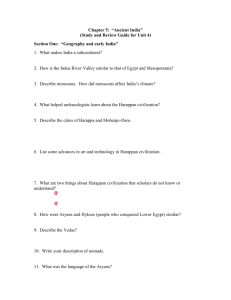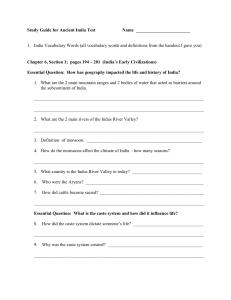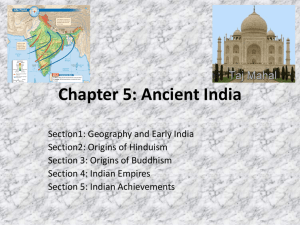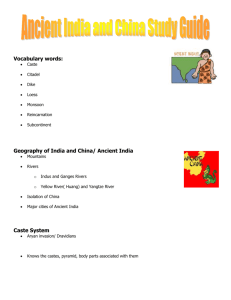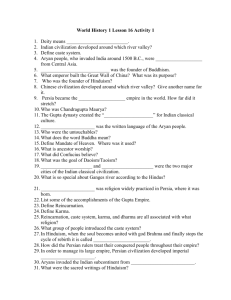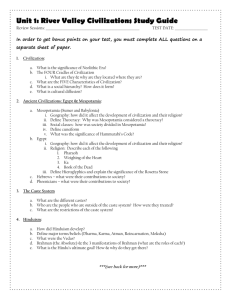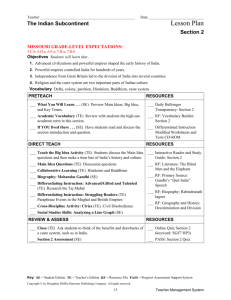Chapter 5: Ancient India
advertisement
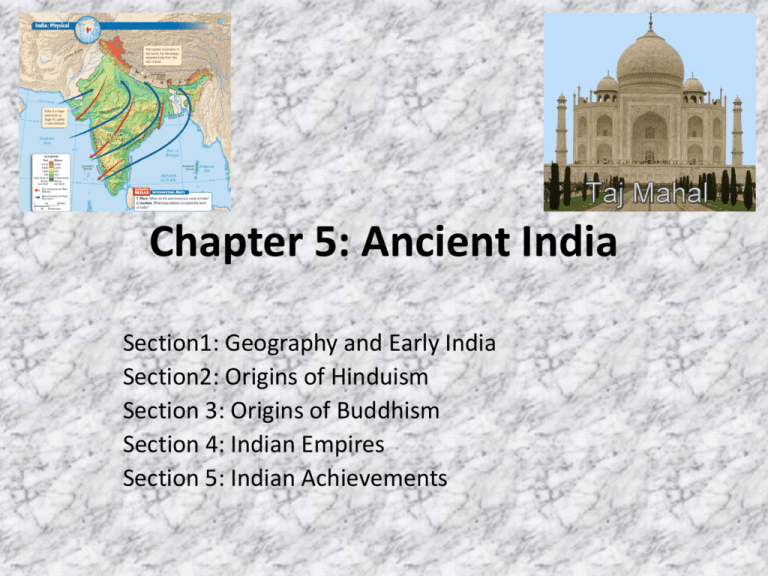
Chapter 5: Ancient India Section1: Geography and Early India Section2: Origins of Hinduism Section 3: Origins of Buddhism Section 4: Indian Empires Section 5: Indian Achievements Bell Work 10/16 List previously discussed ancient civilizations and one fact about each Hint: There are 10 civilizations Civilization Fact Building Background Knowledge Like Mesopotamia and Egypt, India was home to one of the world’s first civilizations. Like other early civilizations, the one in India grew up in a river valley. But the society that eventually developed in India was very different from the ones that developed elsewhere. Geography and Early India The Big Idea Indian civilization first developed on the Indus River. Main Ideas • The geography of India includes high mountains, great rivers, and heavy seasonal rain. • Harappan civilization developed along the Indus River. • The Aryan invasion of India changed the region’s civilization. Indian Geography Mountains • North: The Himalayas are the highest mountains in the world. • West: The Hindu Kush provide protection from enemies. Plains and Plateaus • Rivers and melting snow kept the plains fertile (silt due to flooding). • Both sides of the river thrived. Water • Monsoons • Heavy rainfall • Civilizations arose around seasonal rainfall. •Summer (100-200 inches of rain): monsoon winds blow into India •Winter (warm and dry): down from the mountains) Quick Questions • India is called a _____________. • What is a monsoon? • How could you describe the geography of India? • How could you describe the climate of India? Tuesday Humor • What has teeth but can’t eat? •A comb Harappan Civilization People Cities • Population grew in the Indus River Valley. • Harappa (present-day Pakistan) • Growth came as irrigation and farming techniques improved. • Mohenjo Daro • Cities were built as surplus food was produced. • Well-planned public areas • Fortresses for defense against enemies Achievements •Weights and Measures •Wells and indoor plumbing in houses • Pottery, cotton clothing, jewelry • India’s first writing system (but don’t know how to read it) End of Harappan Civilization • Because scholars can not read the writing system, we know very little about Harappan society • Historians think – – – – Worshipped many gods Had central governments and kings Ended due to invaders destroying the cities Or ended due to natural disasters (floods or earthquakes) Quick Questions • What two cities developed in the Indus Valley? • What suggests the cities were well planned? • What achievements did these cities create? • How did the Harappan civilization end? Map Activity Use pages 125 & 127 as guides • Create a replica map of the subcontinent – Use a sheet of notebook paper • Include and Identify: – – – – – – – – – – – Deccan Plateau Indus River Thar Desert Arabian Sea Monsoon Winds Himalayas Indian Ocean Bay of Bengal Harappa Mohenjo Daro Hindu Kush • Create a key for your replica identifying the landforms, rivers, and climate Enrichment: Cool Indian Facts Quick Fact: India is thirteen times bigger than the United Kingdom Quick Fact: There are more movies made in India (Bollywood) than in the United States. Quick Fact: The customary greeting is done by putting your palms together and with a slight nod of the head, saying "namaste." Tuesday Humor • What has teeth but can’t eat? •A comb Aryan Invasion Invaders from the West Religion Government Language When the Harappan civilization dissipated in 1700 BC, Central Asians called Aryans began taking over territory in the Indus Valley. The Aryans left behind vast collections of poems, hymns, myths, and rituals. They also had religious writings known as Vedas. • First Aryans could not read and write/oral tradition No central government: small communities ruled by rajas; some rajas were related, but often fought with each other until they fought outsiders Sanskrit is the root of many modern South Asian languages. -only a spoken language at first Summary Harappan Civilization • Two major cities: Harappa, Mohenjo Daro • Advanced civilization that thrived between 2300 and 1700 BC • Culture, artistry, city planning Aryan Invasion • South Asian warriors pushed through the Hindu Kush mountains and settled in the Indus Valley • Oral tradition in religion and mythology resulted in the most important language of ancient India: Sanskrit. Quick Questions • What group of people settled in the Indus Valley after the Harappan Civilization crumbled? • What was the name of their religious writings with poems, hymns, and myths? • The most important language of ancient India is called ____________. Wednesday Humor • What did the traffic light say to the car? •Don’t look I’m changing Create Foldable • 2 sheets of paper, individually folded hot dog style • 1st paper cut into 6 spaces • 2nd paper cut into 4 spaces with the 3rd space being the largest • Label the spaces correctly Origins of Hinduism The Big Idea Hinduism, the largest religion in India today, developed out of ancient Indian beliefs and practices. Main Ideas • Indian society divided into distinct groups under the Aryans. • The Aryans practiced a religion known as Brahmanism. • Hinduism developed out of Brahmanism and influences from other cultures. • The Jains reacted to Hinduism by breaking away to form their own religion. Indian Society Divides Varnas Social divisions in Aryan society Brahmins Priests Kshatriyas [ksha-tree-uh] Rulers and warriors Vaisyas [vahys-yuh] Farmers, craftspeople, and traders Sudras [soo-druh] Laborers (servants, workers) and non-Aryans Untouchables Complete outcastes Caste System http://www.youtube.com/watch?v=Oh_xvKLhZHg Individuals • Place in society based on birth, wealth, or occupation • 3,000 castes once existed in India. • Individuals could rarely change castes. Caste Rules • Sutras (guides) listed all the rules for the caste system. • Breaking rules resulted in a transfer to a lower class. Quick Questions • What do Indians call their social class system? • What are the varnas of India? • How does a person become a member of a caste? • What did the groups do to keep their classes distinct? • Who are sutras? Caste System Activity • • • • • Look at your sign To what group have you been caste? Go stand under the sign of your caste. Brahmins Kshatriyas Vaisyas Sudras Untouchables How do you feel about your placement? Does this seem fair? Brahmanism develops into Hinduism Brahmanism • Aryan priests were called Brahmins. • Wrote Vedic texts, which were their thoughts about the Vedas Evolving Beliefs The Vedas, Upanishads, and other Vedic texts began blending with beliefs from different cultures, creating Hinduism. Hinduism • Many gods • Reincarnation: could be reborn into new forms and castes • Men and women could both gain salvation, but women were inferior (could not read sacred texts) Hinduism • Oldest and Most Complex Religion/Largest Religion in India today • No Founder • Polytheistic • 3 Major gods: Brahma, Siva, and Vishnu • Hindus believe that everything in the world is a part of Brahman Hinduism • Atman-A person’s soul (personality and character) • Karma-Effects that good or bad actions have on a person’s soul • Dharma-duties to accept his or place in the world without complaint • Reincarnation-process of rebirth that every soul encounters, even Untouchables • Salvation-Moksha Jains[ jahyns] React to Hinduism Origins of Jainism • 599 BC, established as an alternative to Hindu ritualism • Based on the teachings of Mahavira, who abandoned his life of luxury to become a monk Four Principles of Jainism • Injure no life (nonviolence) or Ahimsa • Tell the truth. • Do not steal. • Own no property. Thursday/Friday Humor • This guy went to school and he asked "May I use the bathroom?" • The teacher replied, " no not unless you say your abc's." • The guy said "a b c d e f g h i j k l m n o q r s t u v w x y z." • The teacher asked "Where's the p? • He replied, " running down my leg!" Origins of Buddhism The Big Idea Buddhism began in India and became a major religion. • • • Main Ideas Siddhartha Gautama searched for wisdom in many ways. The teachings of Buddhism deal with finding peace. Buddhism spread far from where it began in India. Siddhartha Quest for Answers Enlightenment • Siddhartha was born a prince, but he questioned the meaning of life. • Found it under the Tree of Wisdom while meditating • Determined to find answers using: • Meditation • Fasting • Learning from different teachers • Called the Buddha (Enlightened One) • Spent the rest of his life traveling and teaching his ideas Teachings of Buddhism Four Noble Truths 1. Suffering and unhappiness are a part of human life. No one can escape sorrow. 2. Suffering comes from our desires for pleasure and material goods. 3. People can overcome desire and ignorance and reach nirvana, a state of perfect peace. People can overcome ignorance and desire by following an 4. eightfold path that leads to wisdom, enlightenment, and salvation. Challenging Hindu Ideas Ancient Ways • The Buddha taught that following the Vedic texts was unnecessary. • Challenged the authority of Hindu priests Changing Society • A more individualistic approach to enlightenment • Rebirth as a means to evolve Caste System • Opposed caste system • The Eightfold Path could lead any individual to nirvana. • The Buddha’s teachings reached all classes. Buddhism began in India and then became a major religion. Buddhism branches out • Asoka, one of the most powerful kings in India, became a Buddhist and spread Buddhism in India and foreign lands. • Buddhist missionaries traveled the world to teach enlightenment. Buddhism splits • Buddhism split into two main sects: Theravada and Mahayana. • Members of the Theravada followed the Buddha’s teachings exactly. • Members of the Mahayana believed that individual interpretation was important. Taj Mahal Facts • Who built the Taj Mahal? – Taj Mahal was built by Emperor Shah Jahan in the memory of his queen Mumtaz Mahal at Agra, India. • When was the Taj Mahal built? – The building of the Taj Mahal began around 1632 and it was completed about 21 years later in 1653. About 22,000 workmen built the Taj Mahal. • What is the Taj Mahal made from? – The Taj Mahal is made from whte marble stone with precious gems and stones pressed into its walls. Brahmins Kshatriyas Vaisyas Sudras Untouchables

